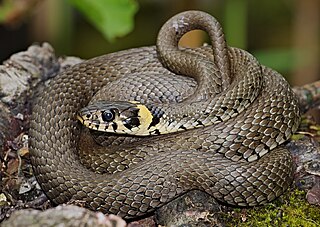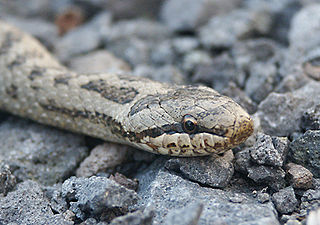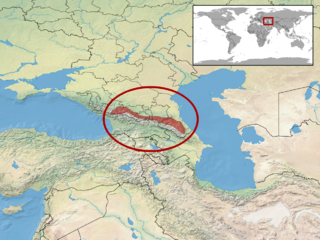 W
WDarevskia armeniaca, commonly known as the Armenian lizard or the Armenian rock lizard, is a parthenogenetic species of Darevskia, a genus of lizards belonging to the family Lacertidae, the wall lizards. Darevskia armeniaca is native to the Armenian Highland.
 W
WThe Asian snake-eyed skink is a species of skink. It is found in Georgia, southern Turkmenistan, southern Tajikistan, Uzbekistan, Kyrgyzstan, western Azerbaijan, eastern Iran, Iraq, Oman, Afghanistan, Pakistan, Jordan, Syria, the United Arab Emirates, northwestern India, and Cyprus.
 W
WThe Caucasian agama is a species of agamid lizard found in the Caucasus, E/S Georgia, Armenia, Azerbaijan, Turkmenistan, Tajikistan, Dagestan (Russia), E Turkey, Iraq, N Iran, Afghanistan, NW Pakistan, and parts of Kashmir.
 W
WThe dice snake is a Eurasian nonvenomous snake belonging to the family Colubridae, subfamily Natricinae. It is also called water snake.
 W
WEirenis modestus, commonly known as ring-headed dwarf snake or simply the dwarf snake, is a species of snake in the Colubridae family. It is native to several Greek islands, Turkey, Syria, Armenia, Azerbaijan, Israel, Lebanon and southwestern parts of the Russian Federation.
 W
WEumeces schneiderii, commonly known as Schneider's skink or the Berber skink, is a species of lizard in the family Scincidae. The species is endemic to Central Asia, Western Asia, and North Africa. There are five recognized subspecies.
 W
WGloydius halys is a venomous pitviper species found within a wide range that stretches across Asia, from Russia, east of the Urals, eastwards through China. Five subspecies are currently recognized, including the nominotypical form described here.
 W
WGloydius intermedius is a venomous pitviper species endemic to northern Asia. Three subspecies are currently recognized, including the nominate subspecies described here.
 W
WThe grass snake, sometimes called the ringed snake or water snake, is a Eurasian non-venomous colubrid snake. It is often found near water and feeds almost exclusively on amphibians. The barred grass snake, Natrix helvetica, was split off as a separate species in 2017.
 W
WThe Greek tortoise, also known commonly as the spur-thighed tortoise, is a species of tortoise in the family Testudinidae. Testudo graeca is one of five species of Mediterranean tortoises. The other four species are Hermann's tortoise, the Egyptian tortoise, the marginated tortoise, and the Russian tortoise. The Greek tortoise is a very long-lived animal, achieving a lifespan upwards of 125 years, with some unverified reports up to 200 years.
 W
WThe large-headed water snake is a species of snake in the subfamily Natricinae of the family Colubridae.
 W
WMacrovipera lebetina obtusa is a venomous viper subspecies endemic to Asia, from central Turkey to northern Pakistan (Kashmir).
 W
WMacrovipera lebetinus is a venomous viper species found in North Africa, much of the Middle East, and as far east as Kashmir. Five subspecies are currently recognized, including the nominate race described here.
 W
WOphisops elegans, commonly known as the snake-eyed lizard, is a species of lizard in the family Lacertidae. The species is endemic to the Mediterranean region and Central Asia. There are nine recognized subspecies.
 W
WPhrynocephalus horvathi is a small diurnal desert lizard in the family Agamidae. It is endemic to the valley of the Araks River and considered Critically Endangered.
 W
WThe smooth snake is a species of non-venomous snake in the family Colubridae. The species is found in northern and central Europe, but also as far east as northern Iran. The Reptile Database recognizes two subspecies as being valid, including the nominotypical subspecies described here.
 W
WVipera ammodytes is a viper species found in southern Europe, mainly the Balkans, and parts of the Middle East. It is reputed to be the most dangerous of the European vipers due to its large size, long fangs and high venom toxicity. The specific name, ammodytes, is derived from the Greek words ammos, meaning "sand", and dutes, meaning "burrower" or "diver", despite its preference for rocky habitats. Five subspecies are currently recognized, including the nominate subspecies described here.
 W
WVipera lotievi is a species of venomous snake in the family Viperidae. The species is endemic to Azerbaijan, Georgia, and Russia. There are no subspecies that are recognized as being valid.
 W
WVipera ursinii is a venomous viper and a very rare species, that is in danger of extinction. It is found in France, Italy, and Greece. Several subspecies are recognized.